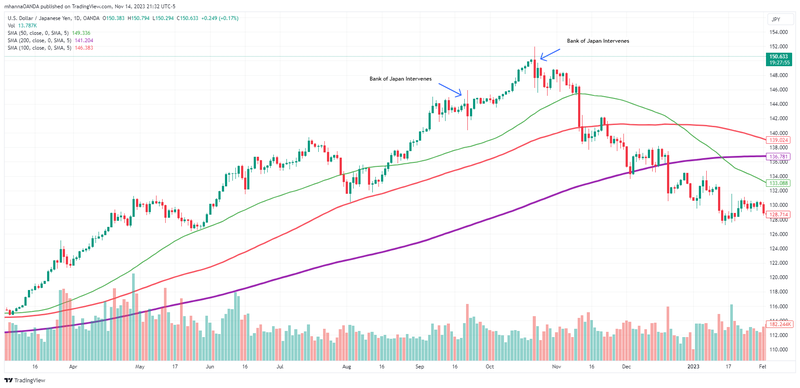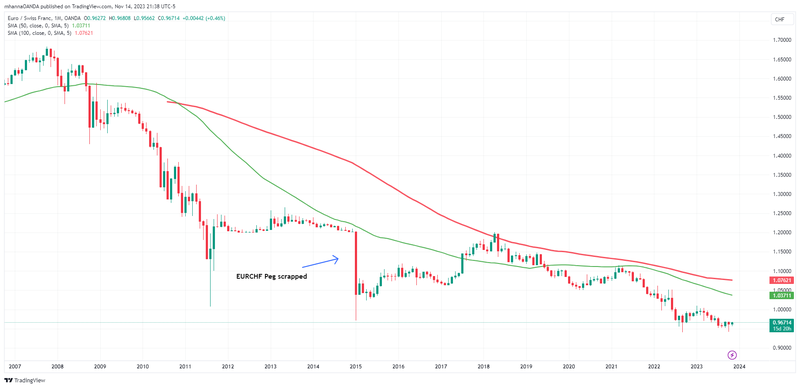Historic Government Interventions in Currencies
In the past, central banks and governments have tried to control currency rates using a variety of tools that include monetary policy, floating exchange rate systems, issuing new currency, and managing foreign currency reserves.
When a country’s central bank or government intervenes in the FX market, it often attracts traders, as some will either anticipate that the intervention will be followed by more extraordinary efforts to weaken or strengthen a currency or that it will create an opportunity to fade the move.
It is nearly impossible to control the FX market, so that is why so many FX interventions have triggered short-term moves against relatively strong trends in the past.
The following points provide an overview and some historical intervention examples as a reference.
Why would a central bank or government intervene?
Depending on the difficulty of achieving their mandate, central banks might need to manipulate their currency to foster economic growth.
For example, a weaker currency could help make exports more attractive for foreign buyers, while a stronger currency could help reduce prices for imported commodities or technologies.
Some countries, such as Brazil, Thailand, Turkey, Sweden, Mexico, and Japan, have managed floating currency systems where the government regularly intervenes to help determine FX market prices.
Free-floating currency systems, such as the US dollar and euro, are used by monetary systems in which exchange rate fluctuations stem from market forces without intervention by country governments.
How do interventions work?
One way of intervening is to impact currency reserves available for the direct buying and selling of a currency. Central banks can conduct intra-policy meetings to attempt to tackle a currency crisis by adjusting monetary policy.
Another form of intervention could be the introduction of taxes or negative interest rates that de-incentivize the public from holding a particular currency.
Notable interventions and historic central bank actions:
October and September 2022
Japan made its first intervention to support the yen since 1998. The yen has fallen over 20% to the dollar this year, and a widening interest rate differential had investors expecting more pain to come the yen’s way.
The September intervention was almost $20 billion as the Japanese yen tumbled to 145.90 against the dollar, a level it hasn’t seen since 1998. The yen's strength was limited, and in October, Japan’s Ministry of Finance bought a record amount of yen against the dollar.
January 15th 2015
The SNB rocked the forex market by unexpectedly ending the Swiss franc peg to the euro. This stunned traders, as a few days earlier they affirmed that they would keep the peg that was set in September 2011 in place. The euro floor of 1.20 to the franc was abandoned, and the key rate on sight deposits was cut by a half-point to -0.75%, a record low.
October 2014
The BoJ stated they will expand its bond-buying program, to now buy ¥80 trillion a year.
April 2013
The BoJ announced a plan to expand its asset purchase program by ¥60–70 trillion a year.
February 2012
Japan confirmed it conducted a stealth intervention in the FX market from November 1st to 4th, 2011. This was the first time since Q1 2004.
October 2011
The BoJ keeps on expanding its asset purchase program by ¥5 trillion to a total of ¥55 trillion.
August 2011
The BoJ boosted asset purchases by 25% to ¥50 trillion and signaled they would continue to support Tokyo’s solo currency intervention to weaken the yen.
March 2011
The G7 agreed to deliver a concerted intervention to prevent yen strength from getting out of control. This surprised many traders, as expectations for some were that the G7 would allow Japan to intervene alone.
October 2010
The BoJ cut rates to 0.00–0.10% and said it would examine the purchase of ¥5T in assets. They would eventually start buying ETFs.
October 2008
The peak of the global financial crisis led to several economic shocks that forced the BOJ to cut rates from 0.5% to 0.3%.
March 2006
BoJ exits QE and raises rates four months later, in July. The short-term rate stood at 0.25%.
February 2004
The G7 is getting frustrated with Japan as intervention continues to lead to a weaker yen. Yen's weakness was short-lived, but it was successful and stopped the BoJ from intervening.
March 2001
The BoJ begins quantitative easing, with the focus being on the pace of money printing and not interest rates. This was a major shift, as they last raised rates in August 1990 to 6.00%.
September 2000
The new euro was under pressure as aggressive selling put the currency at risk of a major collapse. The G7 had to step in and buy €2 billion.
February 1999
The BoJ introduced its zero-interest rate policy.
Summer 1998
The US auto industry was in trouble, and so was Japan’s economy. Confidence was lost with the Japanese yen, and the US was getting worried that Japanese auto manufacturers would crash the US auto industry. Both the US and Japan were concerned that a destabilizing moment for Japan would further worsen the Asian financial crisis. Both countries agreed to sell dollars and buy yen.
Conclusion
It is important for traders to have an understanding of interventions and how they may affect FX market prices. Traders should also be aware in advance of any scheduled or non-scheduled global central bank announcements. An intervention may sometimes be short-lived but in some cases when an intervention becomes a policy, its impact on prices may be felt for longer periods. Test your strategies by using OANDA’s demo account. You can also learn how OANDA’s powerful tools can help you with your market analysis.
Disclaimer
This article is for general information purposes only, not to be considered a recommendation or financial advice. Past performance is not indicative of future results.
It is not investment advice or a solution to buy or sell instruments. Opinions are the authors; not necessarily that of OANDA Corporation or any of its affiliates, subsidiaries, officers or directors. Leveraged trading in foreign currency contracts or other off-exchange products on margin carries a high level of risk and is not suitable for everyone. We advise you to carefully consider whether trading is appropriate for you in light of your personal circumstances. You may lose more than you invest. We recommend that you seek independent financial advice and ensure you fully understand the risks involved before trading. Trading through an online platform carries additional risks. Losses can exceed deposits.




